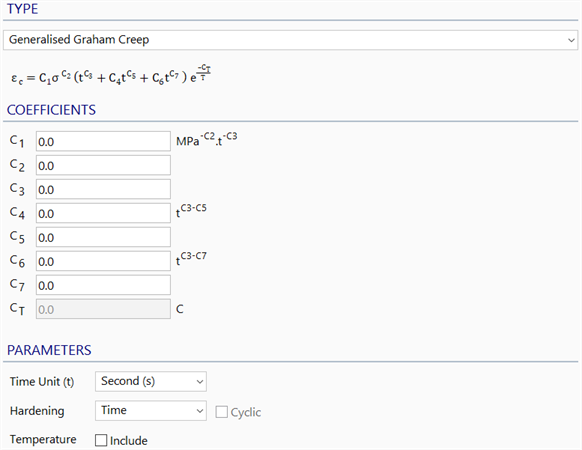Creep: Generalised Graham Creep

Description
Defines creep data parameters according to the generalised Graham creep law.
This generalised expression can be used to describe the creep strain accumulation from the period of decaying creep rate, during the early stages of a creep test, to steady state or secondary conditions.
Toolbar Functions
See LAYOUTS: Creep.
COEFFICIENTS
C1 is the creep strain coefficient.
C2 is the creep stress index.
C3 is the first creep time index.
C4 is the second creep time coefficient.
C5 is the second creep time index.
C6 is the third creep time coefficient.
C7 is the third creep time index.
CT is the creep temperature coefficient.
PARAMETERS
Time Unit (t)
The unit of time in which the coefficients are specified.
Hardening
The creep hardening rule determines whether the creep strain rate is a function of the elapsed time or the amount of creep strain.
-
Time
With this rule, the creep strain rate is calculated based on the elapsed time.
-
Strain
With this rule, the creep strain rate is calculated based on the amount of creep strain in the model. Experimental evidence suggests that the strain hardening rule is to be favoured over the time hardening rule.
If Cyclic is set, extra auxiliary rules are used in conjunction with the strain hardening rule in order to better model stress reversal situations. Such modified strain hardening rule should be used for cyclic loading situations only.
Temperature
This option sets whether the creep law is dependent on temperature or not.
If set, the CT parameter may be specified and the accumulation of creep strain is influenced by the nodal temperatures. The Property Temperature Dependence (see SOLVERS Home: Case Dependence tab) also needs to be assigned in the Quasi-static or Nonlinear Transient Dynamic solver to consider the creep temperature dependence.
If not set, the CT parameter(s) is not used and the creep behaviour is independent of any applied nodal temperatures.
See Also